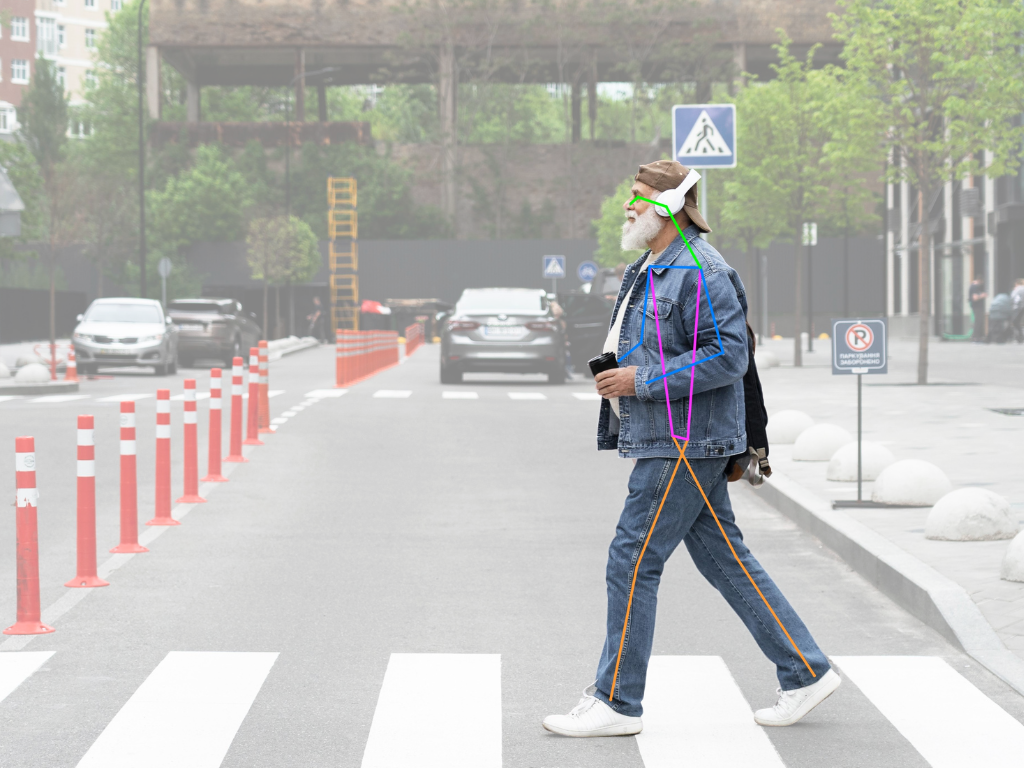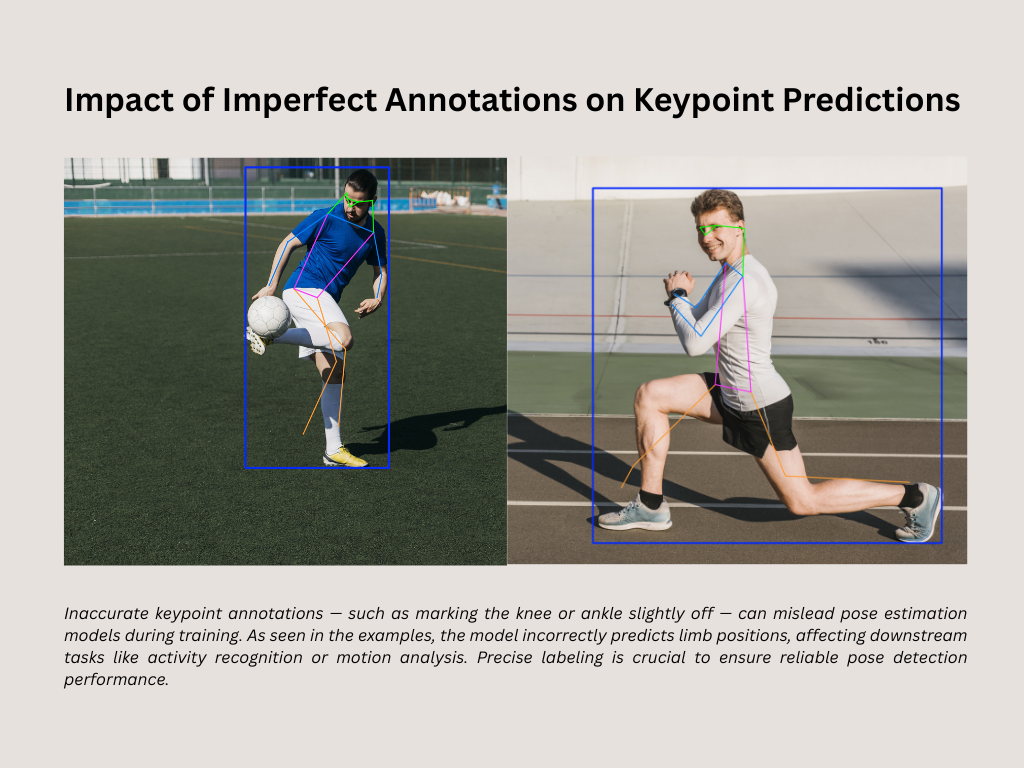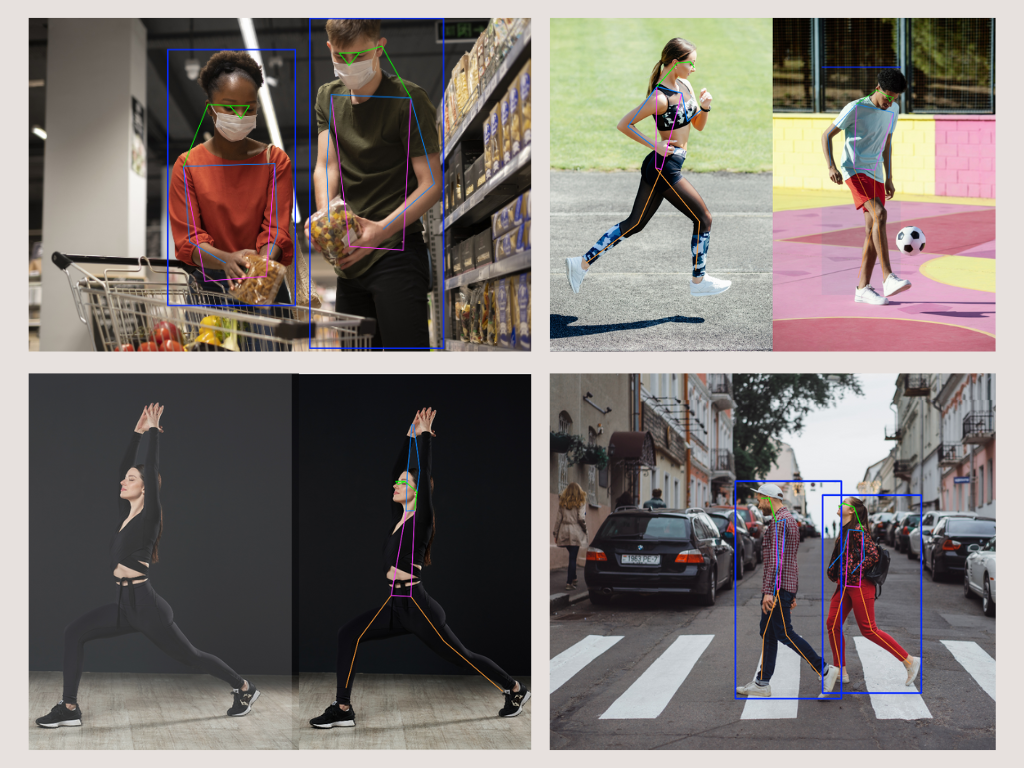How KeyPoint Annotation Works in Pose Estimation and Human Tracking

Ever watched a fitness app track your workout form with impressive accuracy? Or wondered how autonomous vehicles can distinguish between a person standing still versus someone about to cross the road? Behind these remarkable abilities lies a fundamental technique which is keypoint annotation for pose estimation.
KeyPoint annotation has helped countless companies transform raw visual data into intelligent systems that understand human movement. In this guide, we’ll take you behind the scenes of keypoint annotation, showing you not just what it is, but why it matters and how it powers the technology you interact with daily.
Understanding Pose Estimation: The Foundation
Imagine giving a computer the ability to recognize not just that a person exists in an image, but exactly how they’re positioned—their stance, the angle of their limbs, even subtle gestures. That’s precisely what pose estimation accomplishes.
Pose estimation is a computer vision technique that detects human body positioning by identifying and tracking specific points on the body. These points—called keypoints, typically include joints and facial features such as:
- Eyes, nose, and ears
- Shoulders, elbows, and wrists
- Hips, knees, and ankles
When these points are connected, they create a skeletal representation that moves with the person, giving machines a way to “see” human movement.
Two Dimensions vs. Three: Types of Pose Estimation
Pose estimation comes in two primary varieties:
- 2D Pose Estimation maps the human body onto a flat plane using x and y coordinates. Think of it as placing dots on a photograph to mark where each body part appears.
- 3D Pose Estimation adds depth by incorporating z-coordinates, creating a spatial understanding of how far each body part is from the camera. This enables more complex applications like virtual reality and detailed motion analysis.
Processing Approaches: Top-Down vs. Bottom-Up
When implementing pose estimation, two technical approaches dominate:
Top-Down Approach:
- First detects people in the image using bounding boxes
- Then identifies keypoints within each box
Advantage: Often more accurate for individuals
Challenge: Processing time increases with each person detected
Bottom-Up Approach:
- Locates all keypoints in the entire image first
- Then, group these points to form individual skeletons
Advantage: Processing time remains consistent regardless of how many people appear
Challenge: Can struggle with complex, overlapping poses
What is Keypoint Annotation? The Human Touch Behind Machine Vision
For machines to recognize body positions accurately, they need training data—thousands or even millions of examples of properly marked human poses in various positions, lighting conditions, and environments.
Keypoint annotation is the meticulous process of marking these critical points on images and videos, creating the “ground truth” that teaches AI systems to recognize human posture and movement. Keypoint detection algorithms can only be as accurate as the data they learn from, which is why high-quality keypoint annotation is the cornerstone of effective pose estimation systems.
The Keypoint Annotation Process: More Than Just Placing Dots
At Pixel Annotation, our keypoint annotation workflow is defined by precision and consistency:
- Framework Selection: We begin by selecting the appropriate annotation schema based on your project needs, whether that’s the popular COCO keypoint annotation format with its 17 keypoints, MPII Human Pose with 16 points, or a custom configuration developed specifically for your application.
- Specialized Keypoint Annotation Tool Implementation: Our annotators use professional-grade keypoint labeling tools designed specifically for keypoint marking, allowing for pixel-perfect placement and efficient workflow.
- Methodical Marking: Each keypoint is placed following strict guidelines for anatomical accuracy, with consistent ordering and protocols to ensure uniformity across your entire dataset.
- Occlusion Handling: Real-world scenarios often include partially visible subjects. Our keypoint detection specialists are trained to properly flag occluded keypoints and estimate positions based on human anatomical knowledge when appropriate.
Quality Assurance: Every annotation undergoes multiple review stages, with both automated checks and human verification ensuring anatomical correctness and adherence to project specifications.
Why Quality Matters in Keypoint Annotation
Have you ever used an application that just couldn’t seem to track your movements correctly? Or a virtual try-on feature that misaligned with your body? Chances are, poor annotation quality was the culprit.
At Pixel Annotation, we’ve seen firsthand how the quality of keypoint annotation directly impacts model performance:
- Precision: The difference between marking a wrist joint versus the middle of a forearm can determine whether a gesture-controlled interface responds correctly or fails.
- Consistency: When keypoints shift positions between similar images, the resulting model becomes confused and unreliable.
- Completeness: Missing keypoints create blind spots in the model’s understanding, causing failures in specific poses or situations.
That’s why we invest heavily in annotator training, quality control processes, and specialized keypoint labeling tools—because we know your AI can only be as good as the data it learns from.

Real-World Applications: Where Your Annotated Data Makes an Impact
The keypoint data we help create powers innovations across numerous industries:
Physical Therapy
- Keypoint-enabled applications track patient movement during rehabilitation exercises, ensuring proper form and measuring improvement over time.
- Patients receive immediate feedback on their technique, leading to faster recovery and reduced risk of reinjury. One of our healthcare clients reported a 32% improvement in patient compliance after implementing their keypoint-powered rehabilitation app.
Fitness & Sports Analysis
- Smart fitness systems analyze workout form in real-time, counting repetitions, measuring range of motion, and providing feedback on technique that even experienced trainers might miss.
- Users gain access to personalized guidance anywhere, anytime, without the cost or scheduling constraints of human trainers, making professional-quality fitness instruction available to everyone.
Retail & Shopping
- Virtual fitting technology uses keypoints to accurately map clothing items onto the customer’s body, creating realistic previews without physical try-ons.
- Retailers implementing these systems report significantly higher customer satisfaction and reduced returns. A leading fashion brand we partnered with saw return rates drop by 24% after launching their keypoint-powered virtual fitting room.
Security & Safety
- Advanced surveillance can identify concerning movement patterns or restricted behaviors without capturing or processing personal identifying information.
- This approach creates security systems that focus on actions rather than identity, protecting public spaces while respecting individual privacy in ways traditional cameras cannot.

Advanced Keypoint Annotation Tools and Technologies
At Pixel Annotation, we leverage cutting-edge keypoint annotation tools that streamline the process while maintaining exceptional quality. Our comprehensive toolset includes:
- Custom CVAT keypoint annotation configurations for efficient joint marking with anatomical accuracy
- Semi-automated keypoint suggestion algorithms that speed up the process while maintaining human oversight
- Specialized quality assurance interfaces designed specifically for keypoint verification
- Compatibility with standard formats including industry-standard COCO keypoint annotation format
- Custom export options tailored to your specific model training pipeline
These advanced keypoint labeling tools enable our annotators to work efficiently while adhering to the stringent quality standards required for effective pose estimation models. When you partner with us, you gain access not just to expert annotators but to an entire ecosystem of specialized annotation technology.
The Pixel Annotation Difference: Why Partner With Us?
When you choose Pixel Annotation for your keypoint annotation needs, you’re not just outsourcing a task—you’re gaining a partner invested in your project’s success. Our approach combines technical precision with responsive service:
- Specialized Expertise
Our annotators aren’t general-purpose data labelers; they’re keypoint specialists with anatomical knowledge and training specific to human pose estimation. - Customization Capabilities
We adapt to your project’s unique requirements, whether that means following established frameworks like COCO or developing custom keypoint schemas for specialized applications. - Scaled to Your Needs
Whether you need a few hundred images for a proof-of-concept or millions for a production-grade model, our team scales to match your timeline and volume requirements. - Quality-First Philosophy
We’ve built our reputation on delivering exceptional accuracy, with multi-layered quality controls and validation processes that ensure your data is ready for production use.
Transparent Communication
Your project manager provides regular updates on progress, quality metrics, and any challenges encountered, keeping you informed throughout the annotation process.
Beyond Basic Annotation: Advanced Keypoint Services
As your needs grow, our capabilities extend beyond basic keypoint placement:
- Temporal Keypoint Tracking
For video data, we ensure consistency of keypoints across frames, enabling smooth tracking and analysis of movement over time.
- Multi-Person Interaction Annotation
We specialize in complex scenes with multiple people interacting, maintaining keypoint accuracy even with overlapping subjects.
- Domain-Specific Annotation Sets
From sports-specific movements to medical applications, we develop specialized keypoint configurations tailored to your industry’s unique requirements.
Conclusion
In a world where machines are increasingly expected to understand and interact with humans, keypoint annotation stands as a critical enabler of that intelligence. From improving patient care and workout performance to enhancing virtual experiences and public safety, the precision and quality of annotated data are what set exceptional AI systems apart.
At Pixel Annotation, we combine domain expertise, cutting-edge tools, and a commitment to accuracy to deliver data that fuels real innovation. Whether you’re just getting started or scaling to millions of images, our team ensures that your models are built on a foundation of trusted, high-quality annotations.
Let’s bring clarity to your computer vision models. Get in touch to explore how we can support your pose estimation and human tracking projects.
ALSO READ : Sports Data Annotation: The Rise of AI and Data Annotation in Sports